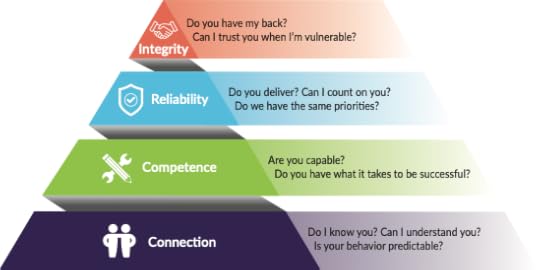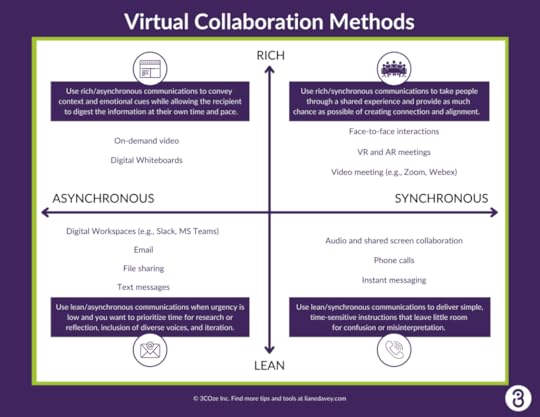Liane Davey's Blog, page 18
April 10, 2022
Why Your Strategic Planning Needs More Insight
Can I rant for a moment?
The way most organizations develop their strategy is a useless paper-pushing exercise that makes me want to rip my hair out. It’s vanilla, formulaic, one plus one equals two, and as a result, most business strategies are utterly devoid of wisdom. What a giant waste of time.
And a huge lost opportunity.
Great strategic planning is less vanilla and more Rocky Road or Raspberry Ripple. It’s full of twists and turns and serendipity. It can be frustratingly one step forward, two steps back. But as you keep at it, something powerful emerges… insight!
I love facilitating this kind of strategic planning because I thrive on the challenge of looking at a forest of complex, dynamic, seemingly unrelated trends and finding a unique path through trees that will get a company further, faster than its competition. It’s invigorating.
Why Your Strategy Process Isn’t Creating insightSo, what keeps you in the mundane, incremental, ho-hum form of strategy? The overarching theme is that you’re trying to do strategic planning the same way you review last month’s financials or the way you evaluate the new performance management process. You treat it like a task that you need to work through efficiently. It’s not going to work. Evaluate your strategic planning process and be honest with yourself about whether you’re doing one or more of the following insight killers.
Are You Trying to Do Strategic Planning Too Quickly?Strategic planning is not something you can fit into a two-day meeting once a year. You need time to follow tangents. You need to let ideas marinate. So ideally, strategic planning is a series of two-day sessions over four to six months. That leaves room to process what’s happening and wend your way through a few dead-end trails before finally seeing the sun coming through the trees.
 Are You Trying to Make Strategic Planning Too Orderly
Are You Trying to Make Strategic Planning Too OrderlyI find that strategic planning processes are often stewarded by people who crave order and precision. They like project plans and Gantt charts, and detailed agendas. Insight does not come when called. It’s fickler than that. Sometimes, you’re on step 3 of the process when you realize you missed something fundamental at step 1. If your Director of Strategy refuses to let you back up the bus, you’ve left insight in the dust on the side of the road.
Are You Only Looking Internally?A strategic planning process should gather steam by looking at the world outside your organization and all the possibilities it offers, rather than with people droning on about the current state inside your company. It usually starts with at least the intention to view the world from some distance. Still, it quickly devolves to the point that participants are talking about internal strengths, weaknesses, or constraints. If you only look within your company, you’re not going to find much that’s new. The best you’ll get out of a strategic planning exercise full of navel-gazing is a glorified continuous improvement process.
Do You Have the Wrong People in the Room?Here’s another issue. You might feel like you’re pushing a rope because you don’t have the right people in the room. You need to have strategic thinkers or else you’ll be incrementalized to death. If you’re choosing your strategic planning invite list based on people’s formal roles, you might be missing the brand of thinking that will help you create a breakthrough. And to put an even more cynical lens on it, if you’re only inviting people who benefit from the status quo, they might be reluctant (or downright resistant) to ideas that would disrupt the good gig they’ve already got.
Are You Forcing Your Strategies Into Fixed Categories?I am continually flabbergasted by the lack of creativity in the strategic planning frameworks of the massive global strategy firms. To be fair, I haven’t worked with these firms directly, only with the people who have left these firms to work in internal strategy roles. But man, are they ever rigid and narrow in their thinking. Every strategy has two boxes reserved for growth and operational excellence. Wow… growth… shocking! Shiver-me-timbers! Knock me down with a feather. You paid $6 million for a strategy that says you have to grow?!? Zoinks. Growth is an outcome or a goal, not a strategy!!!! How will you create growth that’s different from what you’re doing today? Where will you grow that’s more advantageous? How will you grow that will allow you to capture market share? OF COURSE, YOU HAVE TO GROW, but growth is not a strategy!!!
Fire any strategy facilitator who comes with a pre-populated template, fire them. There’s no insight to be gained in having the same categories as everyone else. There’s no strategy in that kind of strategic planning.
How to Improve a Strategic Planning Process?So, how do you turn your strategic planning process into an unfettered, electric, insight-fest? Try the following:
Add New InformationIf your strategic planning process is feeling a little dull, go in search of new information you can inject into the conversation. Ask around. Who’s heard or read something that blew their mind? What are your professional services vendors serving up in white papers or research briefs? Which of your competitors has released a new video or a vision of the future? Ideally, you’re looking for something a little shocking–something to shake things up. It doesn’t matter if it’s true or will actually pan out; it only matters if it inspires some new thinking.
Insert the Voice of the CustomerAnother way to get out of your heads and find fodder for new thinking is to engage with customers or prospects. What are they wrestling with? What trends are they paying attention to? And even better than talking to single customers (who might tend to drag you into a tactical conversation about minor irritants), what about immersing yourself in your customer’s industry associations or advocacy groups. What do they imagine for the future? What are they not imagining that they could be?
 Make More Connections
Make More ConnectionsThe most exciting strategic insights come from connecting two things you thought were unconnected. There are many ways to do this. One would be to ask each person around the room to connect two trends and discuss the intersection in the Venn diagram. Where is there an opportunity or threat in combining those two trends? (I have so many client flip charts from 2018 and 2019 that have both “pandemic” and “just-in-time supply chain” written on them. Imagine what would have happened if they had made the connection and understood the threat of just-in-time supply chains in a locked-down world before 2020!)
Ask More Open-ended QuestionsTactical conversations tend to converge quickly. Every time someone asks a question, others are quick to provide an answer. Try doing a few rounds where each statement needs to be followed with 3-5 questions before anyone is allowed to answer. For example, if someone says, “Eighty percent of our customers’ employees want to work at least three days per week from home,” don’t let someone say, “we need to offer more security services for remote workers.” Instead, force the team to come up with the best questions that the idea provokes. Maybe, “What does the typical home office computing setup look like?” “How savvy are remote employees about the security risks on their laptops?” “What are the most material risks companies face with having workers access files remotely?” Then you can decide the order in which you’ll start to tackle these questions. (And as you can see from these questions, it’s not likely that you’ll have the information to answer the questions in the room. Good thing you’re not trying to build a strategy in two days. You’ve got time to go collect some new data.)
Ask, Why Not?It’s tough to have the patience to reach insight if people in the room are jumping to all the reasons why something is not possible. I love the approach my daughter’s grade three teacher took. She let the kids say anything defeatist they wanted as long as the sentence ended with, “Yet!” If one of your colleagues responds to your suggestion with the reason it can’t be done, add a “yet.” Then ask. “It can’t be done yet. What would it take?” If you’re striking off every potential strategy because one person has one reason it won’t work, you’re not going to have many options left. Go back to the impossible, and the improbable have another kick at the can.
If you want your strategic planning process to have more rich insight, you’ll need to feed it with new fodder and then fantasize, follow, and flesh out, before filtering.
You know you’re there when you hear someone audibly, almost awkwardly, exclaim one of the following in front of the whole team:
Wow! I never thought of that! 😃A-HA! THAT would make all the difference. 🤩YES!!! Yes! Yes! Yes! 🤗One last litmus test. If the hairs on the back of your neck haven’t stood up at some point, you’re not done. You haven’t achieved insight. Keep going.
Further ReadingYour Strategy Should Serve Two Purposes
Are you helping or hindering with strategy? A Quiz
Running a great strategic meeting
April 3, 2022
How Can I Be More Strategic?
Looking for a promotion? Want to be paid more? Tired of hearing that you’re “not leadership material?” One of the things you might need to work on is becoming more strategic.
Unfortunately, “strategic” can be a bit of a nebulous term, and someone telling you that you need to be more strategic can feel as helpful as if they told you to be more groovy, or more purple, or more now.
Why Do People Think I’m Not Strategic?One reason that people might say that you’re not strategic is that you behave in ways that are un-strategic, non-strategic, or anti-strategic.
And what do people consider the opposite of strategic? The opposite of strategic is tactical. Now, I would argue that you can be both strategic AND tactical. In fact, you need to be both strategic and tactical. You need high-level insight about where to play, how to win, AND the wherewithal to select the actions that will best advance your cause. But I suspect that when someone says that you’re not strategic, it’s because you contribute significantly more on the tactical side than on the strategic side.
Start there. Before you start trying to be more strategic, try to be less un-strategic by dialing back your tactical contributions.
Signs of Tactical ThinkingTalking about how the world is, rather than how it could beResponding to a teammate’s future-focused ideas with “but…”Driving to closure before exploring optionsSticking to a near-term time horizonFocusing on what to do next (or right now)Converging, reducing options, narrowing the possibilitiesStruggling to tweak an existing approach rather than looking for new approachesTalking about internal strengths and weaknesses rather than external opportunities and threatsOnce you’ve become more aware of the behaviors that might give the impression that you’re a tactical thinker, you can work on adding more strategic contributions.
 Being More Strategic
Being More StrategicIt’s not enough to just be less unstrategic (the grammar police are really hating on me for this phrase). Being less tactical will not win you any kudos if you stop saying anything at all. Instead, you need to shift your contributions to adding more strategic value. Here are a few ways you can do that.
Lengthen Your Time HorizonStrategic thinking requires that you look beyond the world as it is today and anticipate what might be coming. How far out you need to go depends on your role and level in the organization. For many, contributing something beyond the current week or month will seem strategic relative to the myopic focus on the present that dominates most discussions. The more senior your role, the more you’ll have to be thinking out three, five, or ten years to stand out from the crowd.
Focus on Factors Outside Your OrganizationI love the line “No plan survives contact with the enemy,” which I first read in Chip and Dan Heath’s excellent book Made to Stick. Tactical people come up with intricate, elegant plans—works of art, really—they just don’t consider whether their beautiful plans will meet customers’ needs or survive the competition. Minor detail! Being strategic means injecting data and insight about what’s going on outside your organization, not always navel-gazing or even continuously improving.
Understand the Macro TrendsTactical thinkers see activity in the world; they just don’t see how activities in different domains are connected. Strategic thinkers see the order in the chaos and patterns among the points. They don’t just read a story about the emergence of a couch-surfing company (Airbnb); they think about what that means for the hotel industry, what it says about crowd-sourcing trust, how it will increase passive-income, how passive-income will drive the gig economy, how the gig economy will create full-time employee shortages, how full time…. well… you get it. The tactical thinker notices what has happened, the strategic thinker notices what’s happened and asks, “So what?” and “Now what?”
Understand How Your Business (and Your Competitors) Make MoneyOne of the most disruptive forces in business is when a company changes the business model of an industry. To capitalize on these opportunities (or defend against your competitors disrupting you), you need to be keenly aware of how organizations make money. For example, in an industry that gives a service for free by selling customer data, how might an ad-free paid membership create an opportunity? In a software product company, how might a SaaS model be more effective? And in the Airbnb example, how could we become the largest accommodation company in the world with no capital in real estate? No matter what role you’re in, understanding how your company makes money will give you insights that others might not have.
Make ConnectionsStrategic thinking is connected thinking. Companies are stuffed full of people who can analyze the crap out of things. They tear everything apart and go over it with a fine-tooth comb. But too few people are putting things together. That’s your opportunity. Connect trends—how will growing nationalism impact the preferred path to decarbonization? Connect activities—how could the work we’re doing in our Audit practice be more synergistic with our Advisory practice? Connect people—what if I brokered an introduction between two of our most important customers?
Answer Why and Who Questions (Not How)If you want to be viewed as a strategic thinker, focus on answering the why and the who questions. You can answer a few what questions here and there (your tactical colleagues will probably have asked and answered most of them). What you want to avoid, like the plague, is answering the how questions. Focusing on how questions will get you branded as a tactical thinker faster than you can say “KPIs.”
Abandon Ideas in the Face of EvidenceIt’s important to call out one form of imposter masquerading as a strategic thinker—the pipe dreamer. A truly strategic thinker is not afraid of evidence that their plan won’t work; they’re happy to hear it. So be vocal about your willingness to change your point of view based on new or contrary evidence.
The Moral of the StoryIn an era where most of us have the attention span of fleas, finding someone who can lift our eyes to the horizon is so important. For the next month, pay attention to what you’re paying attention to (Woah…so meta). Make your contributions stand out by thinking about what could be, not what is. (With apologies to your tactical colleagues who were quite happy thinking about nothing beyond their afternoon of back-to-back internal meetings.)
Further ReadingHow to Sell Your Strategic Idea
Are you too busy to be curious?
One Simple Way to Sound Smarter
March 27, 2022
How to Strengthen Connection on Remote and Hybrid Teams
Are you finding that your virtual team is productive but not much fun? Are you spending hours with your teammates each week but still feeling like you barely know them beyond the head and shoulders? Virtual teams don’t have to be sterile, boring teams. Here are some ideas for strengthening interpersonal connections and making your team a much stronger unit!
Different Types of ConnectionsBefore you run off and schedule a bunch of time to shoot the breeze with your colleagues, let’s talk about four ways you can use your time together. Each of these categories is important, and you’ll want to select from each as you build out your calendar.
Structured Task-focused TimeStructured, task-focused time is time spent with your colleagues working toward a clear objective. (This could be time spent in meetings with the entire team or working on a project with one or two colleagues.) In any team, this will be the primary way you spend your time together. Unfortunately, too much structured task-focused time in virtual teams can leave humans feeling more like cogs in a machine. I sense that teams are over-indexing on structured task-focused time right now.
Take a look at your calendar and calculate what percentage of your interaction time falls into this category. If it gets into the 70, 80, 90 percent range, you probably feel the adverse effects.
So, what are the alternatives?
Unstructured Work Time Unstructured work time is time spent with your colleagues talking about business, but with less of a structured agenda or a pre-determined outcome. This is blue sky time, brainstorming time, troubleshooting time, update time. (And no, the irony is not lost on me that I’m now advocating for more unstructured time after spending a decade encouraging more use of agendas, primer documents, and preparation to ensure that time together is optimized.)
Unstructured work time is time spent with your colleagues talking about business, but with less of a structured agenda or a pre-determined outcome. This is blue sky time, brainstorming time, troubleshooting time, update time. (And no, the irony is not lost on me that I’m now advocating for more unstructured time after spending a decade encouraging more use of agendas, primer documents, and preparation to ensure that time together is optimized.)
It’s just that after working remotely for a couple of years, I’m pining for some low-efficiency time (and I get the sense that you are, too) because, in the moments that might seem unproductive, there is space for creativity, connection, divergence, and vulnerability. There’s room for sharing, and synthesizing, and serendipity. And so much innovation comes in those moments when we’re struck by something that seemed utterly tangential.
Build unstructured work time into your week:
Have a Friday afternoon open forum to let people ask for advice or supportIf you’re a manager, have an open Zoom line breakfast chat each week where anyone can pop in and get your thoughts on an issueCall a co-worker to have an informal catch-up about what they’re working onInvite in a customer or a consultant to fill you in on trends in the industrySpotlight: Communication BurstsBeing on a virtual team can be highly inefficient, especially when collaborating with people in different time zones. You default to sending emails, which can really slow things down. I learned this by working on a project with a team member in Asia. At 7 pm Eastern, when I finally got a response to a message I sent first thing in the morning, my option was to work into the night or lose another day.
I learned about a technique called Communication Burst, where you schedule a timeframe when everyone on the team will be working. If it makes sense, start the session with a quick video call and then let everyone focus on doing their work independently. (Some people leave the video call running on mute to enhance the feeling that you’re working together.) The magic of a Burst is that when a question or issue comes up, everyone knows that they can address it right away. They can call an individual, huddle with a few people in a quick web call, or respond immediately to DMs or Slack messages.
Running a Burst on your team might mean asking people to be online from 8-10 pm the odd time, but it will be worth it to know that there are times when you can be efficient as a team. Just make sure to schedule a proportional amount of time off that they can use for non-work activities.
Structured Social TimeThis is the time you spend with your team focused on connecting as humans—no need to accomplish any tasks! In structured social time, you create shared experiences; you forge connections through laughter, you see your teammates as more complete people. And while there are options for structured social time that are just silly and fun, there are also activities that will contribute to a healthier and more constructive team dynamic.
 Add one or more of these activities into each quarter:
Add one or more of these activities into each quarter:
This is the time you spend with one or more team members enjoying one another’s company. In unstructured social time, you strengthen the understanding and the bonds with your colleagues. In the office, this is the time you spend having lunch together, or perched with one butt-cheek on someone’s desk debriefing the weekend, or chatting as you walk back from a meeting.
Try these approaches:
Have a team lunch once a month where you leave the cameras on and hang out. Do a couple of rounds where you break out into smaller groups to chatMove all meetings to 45 minutes and use 10 minutes right after the meeting to catch up with one other participantInvite one person in your team or from another team to have a virtual coffee at a set time each weekSend a funny cartoon or video to a colleague that’s working on something particularly challengingSpotlight: BuddiesEarlier this week, I was facilitating an in-person meeting only to learn shortly beforehand that one of the members had a Covid exposure, and he would have to dial in. So I reached out on LinkedIn to ask for advice in running an effective hybrid session when we didn’t have the swanky technology that might have made it easier. Chuck Durfee suggested assigning a buddy for the remote participant who could advocate for him. This is a brilliant idea and doesn’t just have to be for a meeting.
What if each person who works remotely had a buddy? As a buddy, you could be responsible for sharing any informal communication the remote team member might have missed at the water cooler. And you could make sure that the person is being heard in meetings. You could have the person’s back in conversations that they might not have been included in (and could remind people that they need to include the person).
It won’t be suitable for every hybrid team, but I thought that having a buddy in the room where it happens would be a real help to someone trying to feel a part of a virtual team.
Not All Team, All the TimeOne last thought. Investing in stronger connections as a team should not be at the expense of either individual productivity or work-life balance. At the same time that you’re scheduling these team interactions, schedule communication blackouts. Set times when your team won’t be having meetings or calls, won’t be expecting responses to emails, won’t be open to socializing. Legitimize time for efficient independent work and time for people to be offline and not thinking about the team at all.
Further ReadingTeam Building Exercises for Remote Teams
Reset Your Remote Management Approach
How to Onboard New Employees Remotely
March 20, 2022
Are you using the right virtual collaboration tools?
Are you collaborating virtually more often these days? How are you finding it? Are you able to have just as interesting, innovative, in-depth discussions as if you were in person? Are you getting the job done but lacking the quality dynamic of face-to-face? Or maybe you’re finding it downright awful. Whether you’ve had it with withering webinars, equivocal emails, or tedious Teams calls, it’s worth trying some of these techniques to make your virtual collaboration more effective, more efficient, and more enjoyable.
Characteristics of CommunicationsBefore we can talk about the techniques that will facilitate better collaboration, you need to consider a couple of essential dimensions on which communications differ. The key to revitalizing your virtual collaboration is knowing what type of communication your particular effort requires.
 Rich Versus Lean Communication
Rich Versus Lean CommunicationOne dimension on which communications vary is how much context and nuance they convey. Information richness is “the ability of information to change understanding within a time interval.” This ability to change one’s understanding comes from the capacity of the communication medium to transfer cues that help you interpret meaning. For example, rich communication gives you access to gestures, pitch and tone, facial expressions, and body language that help you interpret the person’s words.
Face-to-face interactions provide many contextual cues to help you interpret the meaning of a message, whereas a text message contains few. (One reason that emojis have become popular is that they add emotional tenor otherwise missing from text-only communications.)
When to Use Rich Versus Lean MediaAlthough it might seem like having richer communications is always preferable, they are often more time-consuming and costly than leaner forms, and therefore you should use them sparingly.
Invest the time and energy in rich communications if:
Your message is novel, complex, or equivocal (and might be misunderstood) There is more uncertainty and greater ambiguity The parties to the communication don’t share context, language, or jargon Conflict is likelySuppose you’re dealing with a simple message where the protocols and terms are well-established, and the path forward is relatively certain. In that case, that’s the place to economize by using lean communication methods.
Synchronous Versus Asynchronous CommunicationA second dimension on which communications vary is the timescale of the interaction. Synchronous communication is when the sender and receiver interact with each other simultaneously, whether that is through written text, images, audio, or video. Asynchronous communication is when there is a lag between when the message is sent and when it’s received.
A phone call is a synchronous interaction, whereas a voicemail is asynchronous, as are emails, Slack or Teams threads, and intranet boards.
Advantages of Synchronous Creates a sense of urgency Promotes interaction and idea-sharing Allows immediate response and feedback Creates accountability in the moment Increases social presenceDisadvantages of Synchronous Interrupts focus and flow on other tasks Reduces time for reflection Imposes a uniform commitment of time Often lacks documentation Challenging with time differencesAdvantages of Asynchronous Allows anytime, anywhere access Facilitates the creation of threads Documents that collaboration process Provides time for reflection Reduces social anxiety and increases participation and diversity of ideasDisadvantages of Asynchronous Slows progress on immediate priorities Leaves room for misinterpretations to fester Creates an overwhelming volume of information Becomes impersonal and isolating Reduces the sense of accountability to contribute When to Use Synchronous Versus Asynchronous ApproachesDepending on where in the world your teammates are, it might be easier or harder to coordinate synchronous communication. (I’ve been doing a project with a client in Sydney, and it’s a serious challenge to find times that work with Toronto.)
Invest in synchronous communications when:
The content requires immediate attentionYou want to promote personal connection and rapportThe topic is sensitive and would benefit from everyone hearing it togetherOn the other hand, if the task doesn’t require immediate action and would benefit from more reflection or research time, stick with asynchronous methods.
Picking the Right Collaboration TechnologyIf you combine the two dimensions, you can create a 2×2 of collaboration approaches. (Click to download.) Each of the four categories has its purpose and its advantages. Within each category, there’s a range of technologies you can use to maximize the benefits and limit the downsides of the category.
I’ve noticed that many teams I work with have settled into a pattern where they’re using predominantly two collaboration approaches—Zoom calls (or Webex, or Teams) and emails (or Slack, or Teams). In addition, they default to either Rich/Synchronous or Lean/Asynchronous approaches. I hope you’ll consider using a comprehensive range of options to suit your task better.
Take these three examples.
Onboarding—A Case for Screen Capture VideoImagine you’ve hired a new team member in Cleveland, and you’re trying to bring them up to speed on all the software you use to do business. For example, you might schedule a Zoom call and walk them through how to add a new client to Salesforce.com. That would be easy, you could share your screen, and they could watch you and ask questions. The only problem is that we know there’s a lot at stake for the new employee, and because they want to appear competent and make efficient use of your time, they might not be forthcoming if they don’t feel confident. And now imagine when they try to enter a new client independently and can’t remember exactly what you did—ugh.
What if you switched to an asynchronous method instead of using a synchronous method? You could do a screen recording with a voice-over that would give them the warmth and welcome of your voice (and the chance for casual comments like, “I know it makes ZERO sense that we call it that, but we do!”). The difference is that now they have the recording, and they can watch it five times without feeling sheepish. They can go back to it over and over. And better yet, when the next recruit joins, you’ve already got the recording.
Training is a perfect situation for using this relatively rich asynchronous approach.
 Connecting—A Case for a Phone Call
Connecting—A Case for a Phone CallWhat if you want to check in on a colleague who’s been quiet on your virtual meetings recently? It seems intuitive that if you’re trying to show that you care and you value the person, you should do a video call so they can see your face and feel the connection. Interestingly, research by Michael Kraus of Yale University suggests that empathy is stronger (and more accurate) when you forego the video and instead opt for a phone call. There’s something magic in how we attune to someone when we hear only their voice. Plus, you benefit from reducing the stress of intense eye contact that comes with face-to-face interactions. I’ve long advocated for situations where you sit or walk in parallel to reduce the intensity of an exchange. Now we have the virtual team equivalent.
If you think there might be strong emotions involved, friction, or guilt, skip the Zoom pick up the phone.
Co-creating—A Case for Audio and Screen SharingWhen your virtual team needs to co-create something, you might tend to jump on a video call and start brainstorming. Maybe one person takes control of the screen and documents what you’re coming up with. (This is how I facilitate virtually.) It seems like a decent approach, right?!? Maybe not. It takes considerable brainpower to process all the visual cues you’re getting from monitoring your teammate’s faces. You’re trying to figure out how your boss is feeling, whether your colleague is bought in, and what just annoyed Bruce, all based on tiny digital renderings of their faces. It’s not great for keeping your attention focused on contributing. Research by Tomprou et al. suggests that the team’s collective intelligence is higher when you turn off the cameras and instead use audio and screen sharing. It seems to be better synchronization with one another, that’s to thank for the enhanced effectiveness.
If your goal is to be task-focused, productive, or innovative, try turning the cameras off and allowing everyone to focus on the shared screen and the emerging output.
If your virtual collaboration could use a little revamping and revitalization, share the map with your team and discuss how you might shift some of your interactions to a different format better suited to what you’re trying to accomplish. Let me know what you think. Is there a new mode of virtual collaboration you’re going to try?
References
Kraus, M. W.. (2017). Voice-only Communication Enhances Empathic Accuracy. American Psychologist, 72 (7), 644-654.
Tomprou, Maria & Kim, Young Ji & Chikersal, Prerna & Woolley, Anita & Dabbish, Laura. (2021). Speaking out of turn: How video conferencing reduces vocal synchrony and collective intelligence. PLOS ONE. 16. e0247655. 10.1371/journal.pone.0247655.
Hill, N. S., & Bartol, K. M. (2018). Five Ways to Improve Communication in Virtual Teams: New research reveals simple strategies that boost performance. MIT Sloan Management Review, Fall Issue.
Further ReadingChecklist for effective one-way communication
8 Techniques to Make Your Meetings More Effective (Part I)
10 questions to increase collaboration
March 13, 2022
Building Trust in Remote and Hybrid Teams
Trust is critical to the efficient and effective operation of any team. Research suggests that trust enhances productivity, proactivity, and optimism.
But is that equally true for virtual teams? It is!
Recent findings point to an even stronger relationship between trust and performance when teams are comprised of members who don’t work physically side-by-side.
The challenge is that thousands of years of evolution only required us to build trust with those in physical proximity to us (especially anyone within a sword’s length 🤺). Building trust with small, two-dimensional, digital representations of humans is new for us. The notion of trust parlayed over phones and screens doesn’t come as naturally.
Therein lies the challenge. Trust is more important in virtual teams and yet harder to build. So we had better figure out how to overcome this challenge if we want to have happy, healthy, and productive virtual and hybrid teams.
Let’s dig in.
What is Trust?Trust is your willingness to be vulnerable to another based on the expectation they will perform a particular action that is important to you, regardless of your ability to monitor or control them¹.
We use the word “trust” frequently, but I’m not sure that we make that connection to vulnerability as clearly as we should. Trust is difficult and important because it’s all about when we’re vulnerable. And even though vulnerability in a remote team is not about life and death, it’s vulnerability, nonetheless. Trust is high stakes.
Will you tell me what I need to know OR leave me in the dark?Will you think of me for an opportunity, OR if I’m out of sight, will I be out of mind?Will you represent my interests if I’m not in a conversation, OR will I get sold up the creek?Will you prioritize my needs OR put others ahead of me?Will you stick up for me if someone bad mouths me OR will you throw me under the bus?See what I mean? There’s plenty of vulnerability on virtual teams. Imagine how different your behavior would be depending on whether you believe the first half or the second half of each of these quandaries.
The Relationship Between Trust and PerformanceOn one level, it seems intuitive that teams with more trusting relationships perform better, but it’s worth considering why that is. What do people do differently when they trust versus when they don’t? The answer is that they take more risks.
No, not like going ax-throwing with teammates (although on some teams, that would seem like a mighty big risk, indeed).
Trust, which is a form of psychological safety, leads to taking interpersonal risks such as:
sharing information (including information that could be misinterpreted or used against you)asking for help (including admitting weakness or lack of competence)engaging in conflict (including risking being ostracized or triggering retaliation)abandoning control (including leaving yourself open to things going off the rails)adding discretionary effort (including doing favors not knowing if they’ll be returned)Teams that don’t have strong trust will suffer through the repercussions of reduced risk-taking, including functioning with less timely information, less capable and confident contributors, more resentment and unresolved conflict, more micromanagement, and fewer examples of going above and beyond.
It certainly seems worth investing some time and energy to build trust in your team.
Establishing Trust in Remote TeamsI advise teams to look at trust at four levels:

This model is based on research showing that team trust² has three components: ability, benevolence, and integrity. I took a couple of liberties with this academic model.
First, I added connection to reflect a more primal aspect of trust based on how our brains work. At the most fundamental level, trust is about predictability, and predictability is about your connection and comfort with the other person. I think excluding this is a big miss, so I added connection at the base of my trust pyramid.
The second modification I made was to relabel “benevolence” to reliability. First, because the only places I’ve seen the word “benevolent” are in the “Benevolent Order of Water Buffalos,” which was a glorified drinking club at my university and as the first half of “benevolent dictator.” Neither is what I’m going for when getting you to envisage the face of trustworthiness. So I swapped in the word “reliability” to describe the idea that someone will not let you down.
With those caveats, here is my best advice on building trust with your virtual team colleagues.
ConnectionDo I know you? Can I understand you? Are you predictable?
Connection is about increasing your comfort with one another. So in the earliest stages of strengthening your connection with your teammates, you want to familiarize them with how you operate in the world. I like to think of this as providing your Owner’s Manual as if you were a refrigerator and they were trying to figure out where to put the milk, so it doesn’t get too warm and spoil but also doesn’t get too cold and freeze (just my fridge?!?). So I created a simple version of an Owner’s Manual that you and your teammates can share.
Another way to increase your colleagues’ comfort with you is to share information that helps them understand and interpret your behavior without jumping to judgments that might be unflattering. For example, if your team is willing, you can use a personality or style assessment to gain insight into one another. Alternatively, you can share information about your backgrounds, perspectives, or hobbies that will give you context for how and why you and your colleagues show up the way you do.
Other tips would be to invest off-task time together. That can be as simple as jumping on a Zoom call while you all eat lunch or as organized as doing a virtual escape room together.
And if you want one of the easiest hacks around, wear your company gear. Subtle visual cues that you all belong to the same club will help strengthen your connection.
CompetenceAre you capable? Can I be confident? Will you succeed?
 Competence is about increasing your confidence in one another. Research suggests that competence is the first dimension of trust to develop in virtual teams (whereas connection comes first when you’re physically together). Unfortunately, developing competence and getting credit for it can be difficult in virtual teams.
Competence is about increasing your confidence in one another. Research suggests that competence is the first dimension of trust to develop in virtual teams (whereas connection comes first when you’re physically together). Unfortunately, developing competence and getting credit for it can be difficult in virtual teams.
One way to boost confidence is to spend more time upfront talking about how you will approach tasks. Sharing your thinking and asking for input from others will reduce their apprehension and increase their confidence. And when you do run into a challenge, be quick to raise it so that your teammates learn to trust that if there’s an issue, you’ll be transparent about it.
Another approach for building competence and increasing confidence is a technique called virtual knowledge sharing, where pairs of teammates interview one another to share one thing they’ve “cracked” and one thing with which they’re struggling. The approach has a few benefits:
Each person must reflect on their competence as they complete the form in preparation for the session.
The embarrassment of sharing something you’re struggling with is reduced because everyone has to share a struggle.
Effective approaches spread from one person to another.
It’s a technique that I recommend that you try on your team.
ReliabilityWill you deliver? Can I count on you? Do we share priorities?
Reliability is about people’s sense that you’re dependable and will deliver for them when it counts. This form of trust is often eroded in teams because leaders fail to align on priorities or fail to prioritize at all. When you’re overworked and overwhelmed, it’s easy to let a ball drop, not because you weren’t capable or didn’t have integrity, but because you couldn’t cope with all the demands on your time. Regardless of why you drop the ball, it will still put a dent in your colleague’s trust.
There are fewer clues to help your colleagues feel that you’re on the right track in a virtual team. The secret is to be much more explicit about your priorities, efforts, and progress than you would be if your colleague were sitting right beside you.
First, invest in making sure you share expectations from the outset. Use open-ended questions to confirm that you’re thinking about the task the same way—document commitments. Define any terms that leave room for interpretation. Have these commitments in a shared file so everyone can access them as a touchstone.
And I know it sounds paradoxical, but the best thing you can do if you’re going to miss a commitment is to say so and say so early. I see so many people waiting until the last minute, hoping they’ll magically find the time or that they’ll be able to cobble something together that will work. If you wait until the deadline to show your hand, your colleague has few options. If you let them know with lots of notice that you’re not going to deliver (or you might not), you leave them with options. That’s much better in the long run for your reputation as someone reliable than hoping for the eleventh-hour miracle.
IntegrityAre you transparent? Do you have my back? Will you protect me?
Integrity is all about whether your teammates can be comfortable being vulnerable. And the thing to remember is that vulnerability begets vulnerability. So the first thing you should focus on is modeling and encouraging candor. You want to make a safe place for sharing bad news and uncomfortable messages.
To further demonstrate your integrity, ask for feedback from your colleagues. Tell them what you’re working on, or admit your shortcomings and ask for their help. The more you do this, the more likely it will be that you’ll have an open channel of communication when something about them is worrying you.
Another important part of integrity is addressing conflicts before they have time to grow into issues that could erode trust. Raise issues proactively, especially when you can talk about them in a problem-solving tone, rather than once you’re upset or frustrated and no longer thinking like allies.
 Trust is Situational
Trust is SituationalWhich of these four different components of trust will count most will depend on the situation, with some aspects of trustworthiness weighing more heavily in some cases than others. For example, imagine that you’re on a project team and your teammate has been assigned to present your work to the executive team. You might be focused primarily on their competence. On the other hand, if you’re trying to decide who to room with on a business trip, connection might count for a lot more than competence.
Trust is critical to the success of virtual teams. Unfortunately, it can be harder to build trust when you don’t have the shared context, rich body language, and casual interactions you would have if you worked side-by-side. That makes it all the more essential to invest in increasing your comfort with one another, enhancing your confidence, demonstrating your reliability, and earning your vulnerability.
References
¹Mayer, R.C., J.H. Davis and F.D. Schoorman (1995), “An Integrative Model of Organizational Trust”, Academy of Management Review, Vol. 20, 3, pp. 709-734.
² Clark, W.R., Clark, L.A. and Crossley, K., Developing Multidimensional Trust Without Touch in Virtual Teams. The Marketing Management Journal, 20 (1), 177-193.
Further ReadingOne Thing You Can Do to Repair Trust that is Damaged
Another Thing You Can Do to Repair Trust That is Damaged
10 Tips to Prevent Misalignment from Destroying Trust
March 6, 2022
The Pros and Cons of Hybrid Teams
Many teams won’t return to the same office-centric approach that existed before the pandemic drove people to their home offices (and kitchen tables) in March of 2020. Instead, the future of work will include a melange of work arrangements on a continuum from permanent work from home to full-time in the office. The middle ground will be occupied by employees who split their work weeks into a mix of remote and in-person days.
If I were making recommendations solely based on optimizing the success of each employee, I’d be cheering for a mixed remote and in-office approach. That blended model affords the benefits of time in the office for connecting, communicating, and collaborating while still capitalizing on the benefits of working from home, including greater focus, enhanced productivity, and the ability to manage one’s personal priorities.
But I’m not an individual productivity expert. My focus is teams.
And when it comes to the shift to hybrid teams (where some teammates are together in the office while others are remote), I’ll be candid; I’m nervous.
The Challenges of Hybrid TeamsWorking together in an office was a good model. It had issues, but for the most part, we made it work. Working remotely from our homes, farms, or Bali workation rentals was also a viable model—teams have done a remarkable job at functioning virtually for the last two years. In both scenarios, you shared an experience with your teammates. But now, people on your team might have vastly different experiences, and I’m afraid those discrepant experiences might cause rifts.
Challenges in Forming TrustTrust is critical to all teams, but research suggests it’s even more crucial to virtual teams. The irony is that it’s harder to build trust with someone when you aren’t physically collocated. Now play out the hybrid scenario. Some coworkers are physically together. They have downtime at the coffee machine. Perhaps they sit together while they eat (studies suggest that eating together forges connection). At the very least, they can observe one another’s body language and pick up contextual cues that help them interpret each other’s behavior more accurately. It’s a significant disadvantage for the remote workers who don’t have the same informal contact. The challenge of the hybrid team is the disparity in trust between those who work together in the office and those who work from home.
Disparate Access to Information Differential access to communication is another source of issues on hybrid teams. This gap applies to both content and context. Let’s start with content. Remote employees must rely on meetings, email, or activity in the Slack channel for their content. In contrast, in-office employees can chat in the elevator, get an update from the boss as they come out of a meeting, and even learn from overhearing conversations between two other colleagues. That likely means that in-office employees are more in-the-know than those at home. Being better informed can translate into greater productivity, efficiency, or innovative ideas. Managers need to counteract the communication imbalance by being very deliberate about conveying messages to those who aren’t in the office.
Differential access to communication is another source of issues on hybrid teams. This gap applies to both content and context. Let’s start with content. Remote employees must rely on meetings, email, or activity in the Slack channel for their content. In contrast, in-office employees can chat in the elevator, get an update from the boss as they come out of a meeting, and even learn from overhearing conversations between two other colleagues. That likely means that in-office employees are more in-the-know than those at home. Being better informed can translate into greater productivity, efficiency, or innovative ideas. Managers need to counteract the communication imbalance by being very deliberate about conveying messages to those who aren’t in the office.
It’s not just more content that advantages in-office employees; it’s also the context they pick up. I mentioned that in-office employees are likely to pick up valuable information as their manager walks out of a meeting and stops to share a few of the critical outcomes. But imagine that this manager is conscious of the communication gaps and therefore chooses to forego the chat with the in-office employees and replace it with an email to all on the team. Although this solves the problem of different access to content, there are still imbalances. For example, the in-office team might see the boss walk out of the meeting looking frustrated and red in the face. When they receive the email with the boss’ description of the meeting, this context will make a meaningful difference in how they interpret it. For example, the in-office employees might notice the boss’ curtness but attribute it to how much heat she got in the meeting with her boss. Without the contextual cues, the remote employees might interpret the tone in the email as hostility toward them. Context is important. As a manager, take time to be aware of some of these context factors and share them more candidly than you otherwise might. It will help reduce the disparity between your in-office and remote team members.
The Friction of Asking for HelpAnother gap between in-office and remote teammates will be their different access to assistance. Research has shown that remote employees experience more social friction in asking for help than people in the office. Social friction refers to the idea that it’s difficult for remote workers to know what information they need or whom to ask when they know what they don’t know. Further, social friction includes the embarrassment of admitting you need help and the fear of being seen as incompetent. As a result, remote employees are less likely to ask for help.
It’s not all about whether someone asks for help or not. When you’re working side-by-side with someone, and they’re grunting and groaning over a task, it’s easy to know that they might need a hand. When a remote teammate is out of sight, you miss these cues and, with them, the chance to offer help. Over time, the cumulative impact might cause you to assume that in-office people are more talented, more effective, or more efficient than remote workers when the issue is really that the remote team hasn’t been set up for success.
How to Minimize the Issues with Hybrid TeamsThe genie is not going back in the bottle, the toothpaste is not going back in the tube, and the whole team is not going back to the office, so we’ve got work to do to make hybrid teamwork work.
Here are a few things to try to get all the benefits of hybrid teams while minimizing the downsides.
 Invest in bringing everyone together when forming teams or hiring new employees. Relationships that start with in-person connections can be sustained remotely for a long time.Try to coordinate days where everyone is in the office, preferably weekly, but if not, monthly.Have pictures of your whole team in prominent places in the office and shared online spaces. Out of sight doesn’t have to mean out of mind.Avoid hybrid meetings. If you’re meeting while some people are remote, have everyone join through technology rather than having some people together in a room and others on the screen (or phone).Use one of these exercises at the start of your meeting to share contextual information that helps reduce miscommunication and judgment.Establish buddies that pair in-office and remote employees and encourage them to have at least a weekly check-in to share their experiences informally.Use the virtual knowledge-sharing approach¹ to reduce social friction. Pair people up for weekly or bi-weekly sessions to share one thing they’ve figured out and one thing with which they’re struggling. (This approach was shown to be highly effective in removing the social friction of asking for help and showed enhanced performance for almost all employees.)Provide unscheduled time for the team, including open, agenda-free time for team members to talk about what they’re working on or ask for help and off-task time where everyone can socialize.
Invest in bringing everyone together when forming teams or hiring new employees. Relationships that start with in-person connections can be sustained remotely for a long time.Try to coordinate days where everyone is in the office, preferably weekly, but if not, monthly.Have pictures of your whole team in prominent places in the office and shared online spaces. Out of sight doesn’t have to mean out of mind.Avoid hybrid meetings. If you’re meeting while some people are remote, have everyone join through technology rather than having some people together in a room and others on the screen (or phone).Use one of these exercises at the start of your meeting to share contextual information that helps reduce miscommunication and judgment.Establish buddies that pair in-office and remote employees and encourage them to have at least a weekly check-in to share their experiences informally.Use the virtual knowledge-sharing approach¹ to reduce social friction. Pair people up for weekly or bi-weekly sessions to share one thing they’ve figured out and one thing with which they’re struggling. (This approach was shown to be highly effective in removing the social friction of asking for help and showed enhanced performance for almost all employees.)Provide unscheduled time for the team, including open, agenda-free time for team members to talk about what they’re working on or ask for help and off-task time where everyone can socialize.I’m glad that the future of work will look different than the past. I gave up full-time office work more than six years ago, and I would never want to go back. I didn’t like the hour spent commuting, the inability to fit in personal tasks during my day, or the exorbitant amount I spent on pantyhose (seriously!!!).
I know other people who are just as keen to abandon the work-from-home phase and get back to the joys of instant communication and collaboration, the convenience of grabbing lunch in the food court, and the time between home and office to decompress. I’m glad that the future of work can work better for each of us. I just want to make sure that while it works for each of us, it also works for all of us.
1. Sandvik, J. J., Saouma, R. E., Seegert, N. T., & Stanton, C. T. (2020). Workplace knowledge flows*. The Quarterly Journal of Economics, 135(3), 1635–1680. https://doi.org/10.1093/qje/qjaa013
Further Reading
How to Manage Conflict in Virtual Teams
How to Manage Conflict in Virtual Teams
Reset Your Remote Management Approach
February 27, 2022
The Steps to Resolve a Conflict at Work
Have you found yourself in a workplace conflict with no idea how to get out? Read on for constructive options you can use to work through the issue in a way that provides not only a workable solution but also a way of repairing any damage that might have been done to your relationships or reputation.
Examples of Conflict at WorkBefore we talk about rectifying the situation, let’s imagine a few likely workplace conflict scenarios. You:
endorse a different plan from the one your colleagues or boss are supportinghave opposing priorities and are arguing with a teammate over what to do firstare frustrated by the way your boss (or co-worker) is treating youfind a teammate’s behavior infuriatingare being harassed or discriminated against by someone in your organizationThe best conflict resolution strategiesRegardless of the type of conflict you’re facing, there are a few approaches that will increase the likelihood that you get through the argument with the best possible outcomes. The “best possible outcomes” include 1) a plan that works for the organization, 2) trust and engagement among your teammates, and 3) manageable stress for you.
 Try not to fight in the heat of the moment. If you’ve been triggered and can feel your pulse racing or your volume rising, buy yourself some time. If the conflict is happening face-to-face, ask for a moment to collect your thoughts. (There is no shame in showing that you actively manage your emotions. Try saying, “Give me a minute. I want to have this conversation productively.” If the argument has broken out over email or on a Slack channel, type your response into a blank message addressed only to yourself—that gives you the chance to delete it later.Speak in concise sentences. Use as few words as possible to buy yourself even more time to breathe and think. Use open-ended questions to get the other person talking. Try saying, “What’s at stake for you?” or “Who are you thinking of?” or “How do you see this playing out?” You’re trying to minimize the time the ball is in your court. Humans are weird; the more the other person is talking, the more positively they’ll feel about you.Be transparent about what might not be evident to others. If you’re feeling or thinking something that others can’t see, do the work for them—tell them. Be upfront about how the discussion is affecting you. Try saying, “I’m disappointed because I thought we had already agreed.” or “I’m worried about how that plan would land with my customers,” or “It’s upsetting that you thought my presentation was dull.” This strategy might seem like it makes you more vulnerable, but there’s strength in candor. Conflict is more manageable when you’ve got nothing to hide.Focus more on the solution than the problem. Keep the conversation pointed forward, not backward. Find common ground where you can start agreeing with one another. Try “We’re both looking for a way to win this account.” Or “We both want to contribute to the team.” Or “We both want to do the right thing.” If you can find a “we both” statement—a genuine, truthful end state that you both want, start there. That will invoke a problem-solving mindset. Ok, we both want to do the right thing. How do we figure out what the right thing is?Specific Conflict Resolution Strategies by Situation
Try not to fight in the heat of the moment. If you’ve been triggered and can feel your pulse racing or your volume rising, buy yourself some time. If the conflict is happening face-to-face, ask for a moment to collect your thoughts. (There is no shame in showing that you actively manage your emotions. Try saying, “Give me a minute. I want to have this conversation productively.” If the argument has broken out over email or on a Slack channel, type your response into a blank message addressed only to yourself—that gives you the chance to delete it later.Speak in concise sentences. Use as few words as possible to buy yourself even more time to breathe and think. Use open-ended questions to get the other person talking. Try saying, “What’s at stake for you?” or “Who are you thinking of?” or “How do you see this playing out?” You’re trying to minimize the time the ball is in your court. Humans are weird; the more the other person is talking, the more positively they’ll feel about you.Be transparent about what might not be evident to others. If you’re feeling or thinking something that others can’t see, do the work for them—tell them. Be upfront about how the discussion is affecting you. Try saying, “I’m disappointed because I thought we had already agreed.” or “I’m worried about how that plan would land with my customers,” or “It’s upsetting that you thought my presentation was dull.” This strategy might seem like it makes you more vulnerable, but there’s strength in candor. Conflict is more manageable when you’ve got nothing to hide.Focus more on the solution than the problem. Keep the conversation pointed forward, not backward. Find common ground where you can start agreeing with one another. Try “We’re both looking for a way to win this account.” Or “We both want to contribute to the team.” Or “We both want to do the right thing.” If you can find a “we both” statement—a genuine, truthful end state that you both want, start there. That will invoke a problem-solving mindset. Ok, we both want to do the right thing. How do we figure out what the right thing is?Specific Conflict Resolution Strategies by SituationAs we discussed above, there are different types of workplace conflict. Depending on which one you find yourself in, you can augment the universal strategies above with these tailored approaches.
How to resolve a task conflictIf you’re trying to work through a task-based conflict, such as disagreeing about what to do or how to do it, here are some specific techniques to use.
The most crucial factor in a task-based conflict is who owns the decision. If you own the decision, focus on making the other person feel heard and understood, then choose how to proceed. Don’t let the conflict drag on. If the other person owns the decision, focus on broadening their thinking and exposing risks and then back down once you’ve said your piece. Again, don’t let the conflict drag on.
Regardless of who owns the decision, use the following approaches to create a productive dialogue.
Form your questions around the criteria for a good outcome. “What would have to be included to make it a workable solution for you?” Then, once you’ve listened and paraphrased their criteria, add in your own.Expose different perspectives. “How are you thinking about this differently because you’re in sales?” Again, listen, reflect on what you heard, then share what’s unique about your perspective.Ask about stakeholders you don’t understand. For example, “What will the end-users be focused on?” Then, complement their view with the POV of your stakeholders, such as, “I’m thinking about it from the IT and security perspective and what they will need.”Tease apart the difference between what you need to do and how you can do it. For example, if the person is signaling that they’re worried about the implications of an action, ask, “How might we do this in a way that minimizes that risk?” (This is particularly helpful in making space for those who don’t own the decision to impact how the decision is implemented.)When the decision-maker is clear, a task-based conflict should be finite. You disagree, argue, struggle, try to understand, and then the decision is made, and you move on. Don’t be the person who gets to this point and says, “let’s agree to disagree.” More on the problem of letting a task-based conflict drag on here.
How to resolve a personality-based conflictMany of the unsavory interactions at work are not about the work at all; they’re about how people show up and how they do the job. These personality-based conflicts can be particularly grating.
The most critical factor in a personality-based conflict is whether you recognize it as such. As soon as you can label the issue as, ‘I don’t like how they operate,’ rather than ‘I disagree about this substantive issue,’ you can start to reframe your concerns.
 Speak objectively (almost clinically) any time you speak about the other person. Stick to describing what you see and hear (or don’t see or hear). Even this tiny step of translating your feelings into objective behavior might give you some relief from the annoyance. For example, if you think the person is rude, what would you attribute that to? Are they dropping eye contact, speaking over you, or disagreeing with your points?Share what you see as the implications of their behavior. For example, imagine that you’re losing your nut because a colleague is so detail-oriented that they’re nit-picking grammar and typos in what was supposed to be your crappy first draft. You might tell them, “When you focus on typos and grammar on the first draft, I feel like I’m missing your input on the who, what, where, when, and why questions that I want to resolve first.”Describe how you’re interpreting their behavior and see if it changes anything. For example, imagine that your boss has interrupted you three times, and you’re only 10 minutes into your presentation. You might be getting frustrated or feeling powerless. If you say, “When you talk over me, I get the sense that you don’t have confidence in me,” your boss might correct you and say, “Oh my goodness, that’s not it at all, I’m just so excited about this!” That might be enough to change their behavior. Or, you could follow up by asking, “How could you signal to everyone else in the room that you have confidence in me and my plan?”If you feel like you’ve tried a few of these approaches and you’re not making any headway, you can ask others for advice. Be careful not to gossip or complain, but feel free to share what you’re seeing and experiencing. For example, “Every time I’m presenting, Sam interrupts me. I’m worried that’s hurting the team’s trust in me. Do you think that’s an issue? If so, what could I do differently? What have you seen that works to increase Sam’s confidence?”
Speak objectively (almost clinically) any time you speak about the other person. Stick to describing what you see and hear (or don’t see or hear). Even this tiny step of translating your feelings into objective behavior might give you some relief from the annoyance. For example, if you think the person is rude, what would you attribute that to? Are they dropping eye contact, speaking over you, or disagreeing with your points?Share what you see as the implications of their behavior. For example, imagine that you’re losing your nut because a colleague is so detail-oriented that they’re nit-picking grammar and typos in what was supposed to be your crappy first draft. You might tell them, “When you focus on typos and grammar on the first draft, I feel like I’m missing your input on the who, what, where, when, and why questions that I want to resolve first.”Describe how you’re interpreting their behavior and see if it changes anything. For example, imagine that your boss has interrupted you three times, and you’re only 10 minutes into your presentation. You might be getting frustrated or feeling powerless. If you say, “When you talk over me, I get the sense that you don’t have confidence in me,” your boss might correct you and say, “Oh my goodness, that’s not it at all, I’m just so excited about this!” That might be enough to change their behavior. Or, you could follow up by asking, “How could you signal to everyone else in the room that you have confidence in me and my plan?”If you feel like you’ve tried a few of these approaches and you’re not making any headway, you can ask others for advice. Be careful not to gossip or complain, but feel free to share what you’re seeing and experiencing. For example, “Every time I’m presenting, Sam interrupts me. I’m worried that’s hurting the team’s trust in me. Do you think that’s an issue? If so, what could I do differently? What have you seen that works to increase Sam’s confidence?”Remember, as much as it’s part of our language to say, ‘they make me feel x,’ no one can make you feel anything. You are interpreting their behavior in a way that makes you feel a given way. That also means that you can choose to feel differently.
How to resolve a discrimination or harassment issueThere is an essential caveat to my personal accountability approach to conflict. It doesn’t apply if you are being discriminated against or harassed. You don’t need to own another person’s illegal or immoral behavior. If you are being bullied, sexually harassed, or discriminated against, you need to enlist support from human resources, or in the case of criminal behavior, perhaps even the authorities. Immediately start keeping a paper trail of your experiences, with specific, objective descriptions of what you experience and time and date stamps on everything. Then look for organizations in your jurisdiction that can support you.
Final thoughts…
Workplace conflicts are unpleasant, and if left unresolved, they’re unhealthy. Use these techniques to work through the conflict. If you’re open to changing your mindset, your approach, and your position as you learn more, you’ll find that conflict resolution becomes a superpower for you.

New Research on Healthy Conflict
How to Manage Conflict in Virtual Teams
February 20, 2022
Productive Versus Unproductive Conflict Resolution
You could probably benefit from more conflict in your life.
Does that sound strange? Backward? Misguided?
I’ve spent 15 years advising teams, and 90% of those teams started performing more effectively when they had conflict more frequently. And as the team members learned to use conflict resolution to improve their productivity, strengthen their relationships, and decrease their stress, many of them reported back that the techniques were equally, if not more, essential at home.
Of course, not all conflict makes things better. Some conflict makes things much, much worse. What’s the difference between productive and unproductive conflict? How do you stay on the right side of the line? What do you do if you cross the line and need to repair the damage? Great questions. Let’s dig in.
Productive Conflict ResolutionI define productive conflict as a conflict that moves you forward. It unlocks something. Productive conflict first generates insight, then creates possibilities, and concludes with action. In the process, productive conflict strengthens relationships because it opens a line of communication and strengthens the connection between you. And each time you broach a contentious topic and work your way to the other side of it, you also bolster perceptions of psychological safety. The truest and most robust form of psychological safety is not knowing that your team will never fight—it’s knowing that your team can fight and come out the other side unscathed.
What Does Productive Conflict Look Like?There are a few hallmarks of healthy conflict. Here’s what I see in a conflict that gives me comfort that there’s a path through even the most contentious discussion.
 Listening
ListeningYou know that old phrase in real estate that the three most important things are “location, location, location?” Yeah, well, for conflict, I’d go with “listening, listening, and listening.” I’m astounded (really…gobsmacked, floored, flummoxed) by how many conflicts I observe resulting from two people not listening to each other and therefore not getting to the root of the problem. Each time one person misses what the other was trying to say, the intensity (and volume, and frustration) increases, making it less likely that either is going to listen to what comes next.
Take a look at these instructions for what I call “Level III Listening.” Use this approach, and you’ll avoid the majority of conflicts and blaze a path through the rest.
QuestionsUseful, healthy, constructive conflict is full of questions. Questions show that you are eager to learn how the other person sees or interprets the situation. At first, use primarily open-ended questions to expand and deepen the conversation. Open-ended questions, particularly skillfully crafted broad questions, are like blank canvases. How the person chooses to interpret and answer the question gives you rich information about what they value—and understanding what they value is the secret to finding a solution that will work for them. Then, once you’re narrowing in on a solution, use closed-ended questions to lock in the commitment.
EmpathyAnother sure sign that a conflict is making things better is when you start to understand and empathize more with the other parties to the conflict. After each open-ended question and its illuminating answer, you have a slightly different perspective on the problem. You’re learning about the challenge from the other person’s point of view and, in the process, getting clues about where the solution might lie. The result is that your suggestions evolve and have a sense of momentum toward a resolution.
Issue FocusI wouldn’t want to create a list of the characteristics of productive conflict and leave off issue-focused. Issue-focused means that when you’re talking about someone else, you avoid the emotionally laden drama of adjectives like, “this is too rushed,” or “this plan is doomed.” Instead, you talk about the realities of the situation (using verbs and nouns) like “You think a September launch won’t work,” or “You believe that we don’t have sufficient resources allocated for marketing.”
If you want productive conflict, focus on the merits and drawbacks of the proposed ideas rather than the traits or behaviors of the people around the table.
CandorWhile your comments about other people and their ideas must remain as objective as possible, productive conflict is full of moments when you share your desires and fears openly. If deep-seated values and beliefs underlie your positions, it’s courageous and valuable to be transparent about them. For example, you might say something like, “I want to get behind this new plan. I just can’t shake the feeling that I’d be betraying all the people in my team who I sold on the current plan only six months ago.”
When you get these values and beliefs out in the open, it’s easier to know what you’re working with and much more likely that you’ll find a solution that works for you.
Signs Your Workplace Conflict is UnhealthyProductive conflict uses only what you can see from others and shares everything they can’t see about you.
 It’s easy to imagine what unproductive conflict looks like. It’s the opposite of all the things that make conflict healthy.
It’s easy to imagine what unproductive conflict looks like. It’s the opposite of all the things that make conflict healthy.
Here are a few signs that your conflict has turned unproductive.
There are no moments of silence, only frequent interruptions.You hear the words “I” and “You” frequently and very few instances of “We.”People make statements and assertions and don’t ask questions.People repeat the same words over and over.The volume rises as people feel increasingly frustrated.People make assumptions about what others are thinking or feeling.Some people stop talking and disengage.The conversation keeps turning to the past.You hear protestations of “that’s not what I said” or “that’s not what I meant!”Concrete language declines, and adjectives and judgments creep inPeople obscure their motives and the values that are driving their interestsThere are many more signs. What would you add?
How to Fix it if You Mess UpLet’s be fair. When you’re fighting about something you’re invested in, an issue with high stakes and strong emotions, it’s super-duper difficult to be constructive. I get it.
That means sometimes you’re going to start checking off those unproductive signs as if you were racing to win Conflict BINGO.
It’s ok. Seriously. It’s ok.
If it happens, stop as soon as you notice that you’ve lost the plot. Stop. Exhale.
Now, say something to let everyone else you know just clued in that had temporarily been inhabited by a banshee. Take your pick. Go with a nice loud, “crap,” or “sorry,” or “I need a sec’.” The point is to break the pattern and signal to everyone that you’re now in on it.
Then reset. If you’re ok to continue in the moment, try, “I wasn’t listening. Would you take me through your concerns again, please?” Alternatively, go with, “That’s not how we’re going to get to a resolution. I’m sorry. Could we go back to what we’re trying to solve for?” Recommit to engaging in the conversation in a healthy and constructive way.
If you’re not yet calm enough to continue, you might be able to defer the conversation. If so, ask for an adjournment. If you aren’t in a position to postpone the discussion, pull back and give yourself a few minutes to settle. Try taking some notes about what people are saying to key in on what you’d been missing.
Later, find an opportunity to acknowledge that you weren’t at your best. Be vulnerable about what was going on. If you can get the word “sorry” to come out of your mouth, great. If you just can’t spit that one out, try thanking people instead. “Thanks for bearing with me while I lost my nut yesterday.” If you have something constructive to offer, that would be a good fit. “Before we dive back into finding a solution, could we take a few minutes to talk about what we see as the problem. I think we might be trying to solve different things.
Let’s make that a little easier to follow… When you behave poorly in a fight, do these things:
Notice. Stop. Exhale. Signal. Reset. Recommit. Acknowledge.
[As a career-long consultant and lover of all things words, it’s killing me that this isn’t a nifty acronym. But man, do I hate a trite acronym where people bastardize the parts of speech or highlight the second letter to make it work, so can we forego the abbreviation?]
Getting good at having productive conflict means you can get out of conflict debt and avoid the profound costs of conflict avoidance. Try it the next time a discussion gets heated.
Further Reading
Is it Manipulative to Use Productive Conflict Techniques?
Exercise: Fostering a Culture of Productive Conflict
New Research on Healthy Conflict
February 13, 2022
The importance of conflict resolution at work
Are you ever tempted to keep your mouth shut rather than start an argument? Do you think to yourself that it would be easier to agree to disagree so that you can keep moving, maintain harmonious relationships, and avoid triggering one of Susan’s epic hissy fits?
I get it.
Getting embroiled in a fight at work can suck.
The only problem is that you can’t get out of a fight until you get into it. And the alternative to getting to the other side of a conflict is to be held hostage by it. In The Good Fight, I refer to that as getting into conflict debt. And much like racking up credit card debt, the costs of conflict debt compound the longer you leave it unresolved.
What are the Costs of Conflict Avoidance?The price you pay for carrying conflict debt is high (think penalties and compounding interest)—and it’s not just you who pays. Leaving issues unresolved is costly to your business, to your colleagues, to you, and often to your family and friends. The next time you tell yourself that the price of avoiding a conflict is a price you’re willing to pay, think about whether everyone else wants to be on the hook for your tab.
Consider the following:
Impact of Conflict Avoidance on Your OrganizationYou might have issues with your team’s plan for a new store format, but isn’t it your decision whether to raise it or not? Well…yes, it’s always your decision whether to open your mouth. You’re going to be the one to bear the brunt of it if your concerns evoke ire or trigger a tirade. While you’re thinking about the risks of saying something, it would be great if you also thought about the downsides of not saying anything.
 Diluted Resources
Diluted ResourcesWhen you back away from forcing trade-offs, you perpetuate the pervasive problem of diluted resources. If your team needs to make a call on one approach versus another, don’t let anyone try to pass off the trite BS about the “power of the and.” If no one has the guts to force a trade-off between two options, you’ll commit to both but decrease the likelihood that either will succeed. (Not to mention that you’ll sign everyone up for an even more overwhelming workload.)
Don’t spread the love if it means you spread it too thin.
Stifled InnovationAvoiding conflict is also a sure-fire way to stifle innovation. If you aren’t willing to fight for a breakthrough answer, you’ll probably end up with a mediocre, incremental solution. (As they say, a camel is a horse designed by a committee.) If no one cares enough to let the conversation get heated and a little messy, you’ll end up vulnerable to the competitors who have the guts to dream bigger.
Don’t ignore a battle if it will help you win the war.
Stalled ImplementationChoosing to avoid conflict does not mean you’re choosing not to hold a grudge. If you pass on making your concerns known, you set up for stalled and bumpy implementation. If no one is willing to slow things down long enough to resolve the issues, you better be prepared for lengthy delays, people reopening the decision through back channels or active sabotage of the program.
Don’t be a hare at the start when the tortoise crosses the finish line sooner.
Poor Risk MitigationAvoiding conflict is also a problem if risks are left unexposed. If the concern you’re choosing not to express affects the success of the plan, then staying silent means leaving the issue buried. If no one is willing to call out faulty assumptions, name the potential pitfalls, or expose the downside risks, you’re setting yourself up for trouble.
Don’t leave land minds buried if you’re the one likely to step on them.
Impact of Conflict Avoidance on Your TeamConflict avoidance is bad for business. But, unfortunately, it’s also bad for teams. Leaving issues unspoken can allow interpersonal wounds to fester, and resentment is toxic to teams. So before you decide not to rock the boat, consider these implications of conflict avoidance on teams.
 Eroded Trust
Eroded TrustAvoiding conflict with a teammate seems like it should be good for trust, not bad for it, but if your teammates can’t count on you to be candid with them, can they count on you at all? If no one is kind enough to say the uncomfortable things to one another directly, how will anyone have confidence you have their back when it counts?
Don’t be nice if it means being unkind.
Uneven WorkloadSometimes the conflict you’re avoiding is the one where you say, “Hey, how come I’m getting more work than everyone else?” It’s so common for managers to keep loading work on the people who consistently deliver and slowly let out slack to those who can’t or just don’t. If you aren’t willing to advocate for yourself, don’t be surprised if the workload gets way out of whack.
Don’t let your manager keep adding things to your plate if something’s going to drop.
Declining EngagementThere are few things more demoralizing than facing the same problems week after week, month after month, year after year. Getting that monthly statement of how your conflict debt is accumulating is demoralizing. If no one cares enough to make it better, no one cares enough.
Don’t suck it up if sucking it up is making it suck.
Impact of Conflict Avoidance on Your and Your FamilyI never know in which order to describe the profound costs of conflict debt. I’m not sure which is worse, that conflict debt causes excessive waste that hampers our businesses, that conflict debt poisons our relationships at work, or that it’s slowly killing us and taking down the people we love.
Ok, who am I kidding? It’s that third one that matters most. For most businesses, conflict debt is a self-inflicted wound. If you’re not speaking up, it’s probably because of a toxic culture, a crappy boss, or the tolerance of vindictive behavior from colleagues. My sympathy only goes so far.
But when it comes to the cost of workplace conflict avoidance on individuals, that’s where I get sad, heartbroken, even. Conflict avoidance is costing you.
Increased StressWhen you avoid a conflict at work, it’s doesn’t go away. For the most part, you can’t just “move along.” Instead, the issue haunts you: an intrusive thought interrupting you while you’re trying to be productive; a scenario playing out over and over in your head at 3 am, or a general feeling of dread hanging over you even when you’re at home. If you’re not making a dent in the conflicts at work, you’re letting them make a dent in you.
Don’t swallow a toxic issue and think it won’t poison you.
Divided AttentionYou can’t usually avoid a conflict once and be done with it. Avoiding conflict is a process, one that requires you to invest energy to continually duck, dodge, and defer the issue. (That’s why the debt metaphor makes sense, the interest compounds.) If you aren’t willing to resolve a problem once and for all, worrying about it will drag you down, and the residual effects will make you less productive.
Don’t let an unresolved issue live rent-free in your head; you’ve got more important tenants.
Emotional ContagionWhen you carry a conflict home from work, it’s evident to everyone who cares about you. Your frustration, anger, or hurt feelings will show up as being distracted, having a short fuse, or just being unpleasant to be around. If you don’t make a point of resolving issues with the people at work, you’ll create issues with the people at home.
Don’t carry an issue home if you’re going to spread it to the people you love.
When a conflict starts brewing at work, it’s so tempting to bite your tongue, suck it up, pick your battles, and steady the boat. After all, you could make a case that doing so would help you go faster, strengthen your team, and be way less stressful for you. Sadly, it doesn’t usually work that way. Avoiding conflict only allows it to grow. Until you pay off your conflict debt, you pay a heavy price for the privilege of carrying it.
Further Reading
Don’t pass conflict aversion to the next generation
February 6, 2022
How to deal with passive aggressive people
My completely unscientific LinkedIn poll results are in, and dealing with passive-aggressive people is the conflict situation you despise the most. I agree. Passive aggressiveness has all the unpleasantness of other more transparent conflict scenarios, with fewer opportunities to improve things. Passive aggressive behavior is the ultimate in unproductive conflict.
What Is Passive Aggressiveness?Passive aggression is the indirect expression of negative feelings or emotions. A person behaving passively aggressive will channel their dissent, dislike, or disagreement into subtle behaviors that allow them to signal their resistance without provoking a direct response.
There are many reasons why someone might manifest their frustrations passively, including:
They can’t defend their feelings, judgments, or desires with evidenceThey are uncomfortable with direct conflictThey feel threatened by the person with whom they disagreeThey choose not to invest the energy required to oppose openlySuppose one or more of these is true. In that case, the person decides that passive-aggressive behavior is a better way to express discontent than outright disagreement.
Signs of Passive-Aggressive CommunicationSpotting passive-aggressive behavior can be challenging because the goal is to keep friction just below the level where it will spark into flames. It’s even harder to detect passive aggressiveness because how someone expresses their displeasure can vary based on their personality, intellect, role, culture, and situation. Watch for these common forms of passive aggressiveness.
GossipWhispering in the shadows is a common way of expressing negative emotions without directly addressing the person at the center of the issue. A person venting their frustrations through gossip is careful to find a safe confidant who will ensure discretion and keep the matter out of the spotlight. In some cases, the person is just hoping for someone with whom to commiserate. In others, they are actively trying to enlist allies, perhaps in the hope of gaining enough strength to confront the issue openly.
If you’re on the receiving end of someone’s emotional download, here’s a quick guide to help you differentiate between healthy venting and toxic gossiping and to respond accordingly.
SarcasmAnother form of passive-aggressive behavior is when a person uses quick, cheap one-liners and sarcasm to shut down a conversation they don’t want to engage in. Sarcasm can be a highly effective strategy because it leaves room for interpretation and plausible deniability. For example, if the person says, “Wooow, Bob. That is the BEST idea I’ve ever heard,” it might be unclear whether they are mocking Bob or not. And if someone rebukes them for the comment, they can retreat to, “WHaaat, I said it was a great idea!” Basic sarcasm is easy to spot. As the intelligence of the passive-aggressive person goes up, the humor and wit become more sophisticated, and it becomes harder to incriminate them.
 Cynicism
CynicismDonnie and Debbie Downer are two more examples of people behaving passively aggressive. Their pervasive cynicism drags an entire conversation down without producing any substantive evidence of a problem. “Tried that.” “That will never work here.” “Yeah, right! I don’t think so!”
ElusivenessSome passive-aggressive behavior comes in the form of hedging, equivocating, or flip-flopping. In this version, you’re not sure where the person stands and can’t put your finger on the reasons for their opposition. They either hum and ha and refuse to commit, or they seem to commit but repeatedly change their stance.
Lack of follow-throughAnother passive form of passive aggressiveness is to agree to something and then stall, make excuses and fail to deliver. In this case, the person might look like they’re fully on board until you notice that they haven’t started rowing.
Denial of eye contact or silenceThe most passive versions of passive-aggressiveness go beyond wishy-washiness, sarcasm, or gossiping all the way to complete disengagement from the conversation. Silence, dropping eye contact, and turning away from the source of the disagreement are all telltale signs that there’s unspoken aggression simmering.
How Can I Stop Someone from Being Passive-aggressive?Dealing with a colleague (or anyone, for that matter) who is behaving passively aggressive is frustrating, even infuriating. You want to get the issues on the table to allow you to deal with them constructively rather than to endure the whispers, ghosting, and eye rolls. (I forgot to mention eye rolls as a grade-A passive aggressive behavior. How could I forget eye rolls?)
There is no magic bullet to dissuade someone from channeling their anger unproductively, but there is a general formula. The person behaves that way because 1) they perceive it as too uncomfortable to raise the issue openly, and 2) they perceive it as relatively safe to express their opposition passively.
Thus, the formula to reduce passive aggressive behavior is to tip the balance in the other direction.
Make it easier to say uncomfortable thingsIt seems counterintuitive, and maybe like your encouraging the passive-aggressive behavior, but you’re not trying to avoid conflict; you’re trying to get it in the open. Doing so requires that you make expressing contrary or unpopular opinions easier. Try a few of these ideas:
Start a contentious discussion by acknowledging that it might be uncomfortable and that you’re counting on people to share their reactions openly.Pause at multiple points in a conversation and solicit opposing points of view.Make it easier to have unformed, unproven dissent by having a code word for it. Make it one of your team’s ground rules that anyone can express a brewing negative feeling without having the perfect defense prepared. The more silly or playful it is, the better it will be at diffusing any tensions. You could try, this is a “flyer,” or a “niggle,” or pretty much any phrase from a Dr. Seuss book, including a “murky-mooshy,” a “obsk*,” or even an “I’ve got a jertain in my curtain.”Refrain from driving difficult decisions to quick closure and leave room for people to raise concerns during a fixed period.Acknowledge, reward, and celebrate when someone says something that contradicts the discussion. Be specific about why their divergent point of view is helpful.Create safe, appropriate places for people to provide feedback about how your behavior impacts them.Use whatever opportunities you can think of to make expressing an opposing opinion as easy and painless as possible.
Then, while you’re at it…
Make it harder to hide uncomfortable thingsThe other reason why people persist with their passive aggressive behavior is that they get away with it. If there are no negative consequences for the eye roll or the gossip, why stop? Your opportunity is to change that.
Respond to every sarcastic comment with a calm, open-ended question. “How do you see that playing out?” “I just caught your body language out of the corner of my eye. What do you think about this plan?”When you get wind of something stinky wafting around in the air, raise the issue in an open forum or a private conversation. “I get the sense that people are upset with how I behaved in the last meeting. I’d appreciate the chance to learn. What advice would you give me?”Provide feedback about how their behavior is impacting you or other stakeholders. “We agreed that you would have the draft back to me on Monday, and it’s now Wednesday. I’m feeling very embarrassed that I haven’t been able to get back to the client.”Use closed-ended questions that leave no wiggle room. Where possible, have them answer in front of other people or create a paper trail of their commitments.Shut down any back-channel decision-making and redirect the conversation to the appropriate forum, “We decided that in the last meeting. Has something changed that makes it worth bringing back to the table?”Now I know it’s hard, but the key here is not to meet passive-aggressiveness with more passive-aggressiveness. Instead, stay calm, keep the questions open, and listen for what’s going on beneath the surface.
* I like the idea of using the Dr. Seuss creature, the “obsk,” as your code word for sharing a dissenting thought because in If I Ran the Zoo, the obsk is a mountain bird with a rockin’ red ‘do and an unbeatable side-eye!
Further ReadingRead the basics of Passive-Aggression at Psychology Today
Check out the article I wrote for Harvard Business Review on reducing passive aggressive behavior on your team
Tools to stop passive-aggressive behavior




